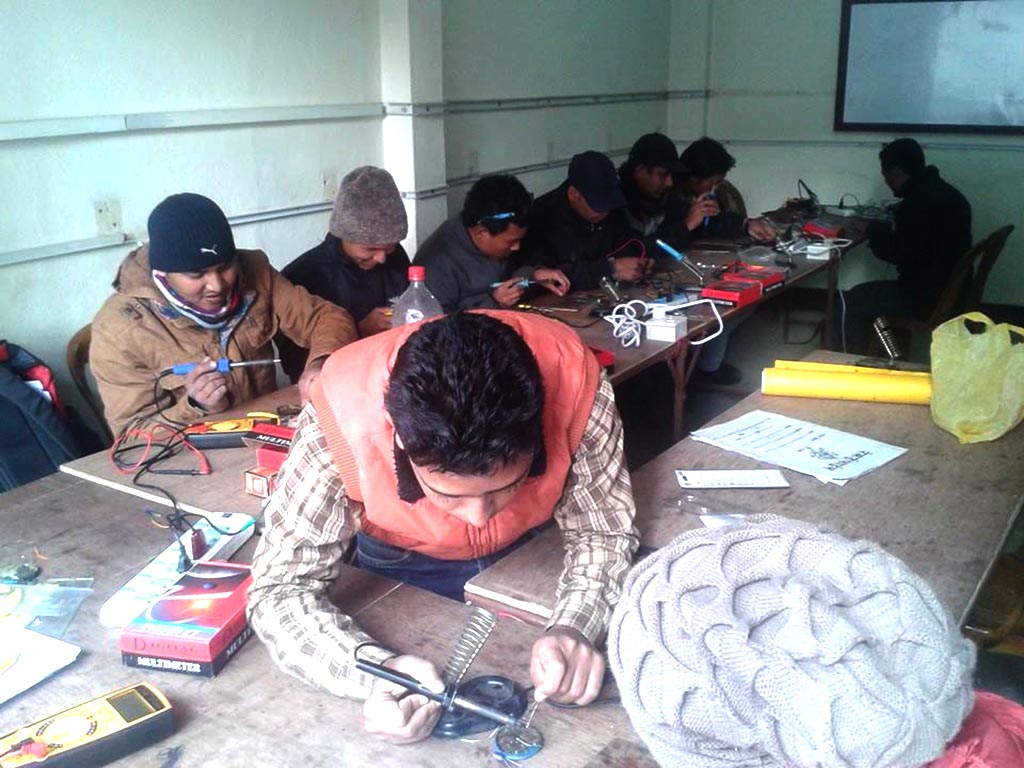Basic Electronics Troubleshooting & Repairing
Basic Electronics Troubleshooting & Repairing

| Name of the Course | : | Basic Electronics Troubleshooting and Repairing. |
| Length of Course | : | 24 days ( 2 hours per day total 48 hrs.) |
| Group Size | : | Maximum 10 Person |
| Theory Practical Ratio | : | 20% and 80% |
| Entry Criteria | : | Interview |
| Eligibility | : | Literate /Fresher can apply |
| Facilities | : | Sufficient Tools equipment and training materials will provide by Tps. |
| Trainers | : | CTEVT certified trainers 10:1 |
| New Class | : | Nepali 1 gate and 15 gate. (If holiday falls on that day than next day will start the new class) |
Course Objectives
After completion of this course, you will able to elementary level of troubleshooting and repairing, all kind of electronics equipment such as power supply, Welding machine, Jogger machine, Electric kettle, induction cooker, Microwave woven, Washing machine, Freeze AC and Electric Vehicle control board etc.
Course Subjects
- What is electricity ? Electricity Differentiate between AC and DC
- Know the importance of safety precaution when dealing with AC and DC in electronic circuit.
- Use of Digital multi meter to measure AC and DC Voltage.
- General circuit idea : open circuits and closed circuits, checking continuity for troubleshooting purposes.
- Ohms law
- Basic components: Symbols, Identify the components.
- Introduction of THT and SMT circuits, Inductor : introduction of coil, inductance and resistance, EMF, Magnetic fields.
- Test most of the basic electronic components using multi-meter, so that troubleshooting works can be performed on electronics equipment.
- Capacitor : Introductions, functions, Series combinations and parallel combination circuits, Calculate the code value of capacitors.
- Resistor : Introductions, functions, Series combinations and parallel combination circuits, Calculate the code value of resistors, potentiometers, measurement of resistors using ohm meter.
- Semiconductor device: Function of diodes, Types of diodes, LED, measurements and trouble shootings, Read semiconductor substitution manual book and find the best replacement parts from search engine, Understand semiconductor part number and datasheet specifications.
- Transistors: Types of transistors, BJT,MOSFET and IGBT. Functions of transistors and their uses in circuits. Important of transistors in electronics circuits.
- IC : Types, Functions linear Ic, Monolithic ic, ASIC
- Types of Switches and their use
- Battery
- Use of bread board, PCB board and Strip board.
- Printed circuit board
- Wire, types, Current ratings and their uses.
- Circuit Assemble : Module 1 Led circuits.
- Remove and solder electronic components from and on to PCB board.
- Module 2, Design and assemble a their one linear unregulated power supply.
- Module 3 Multi vibrator : Make a Multi-vibrator circuit so that they can understand Applications of Transistor.
- Build one electronics project kits that can enhance their assembling, testing and soldering skills, Read basic electronic schematic diagram of a typical equipment (Using 555ic).
- Know where to buy electronics component in local and international market
- Basic trouble shooting technique of any electronics equipment.

